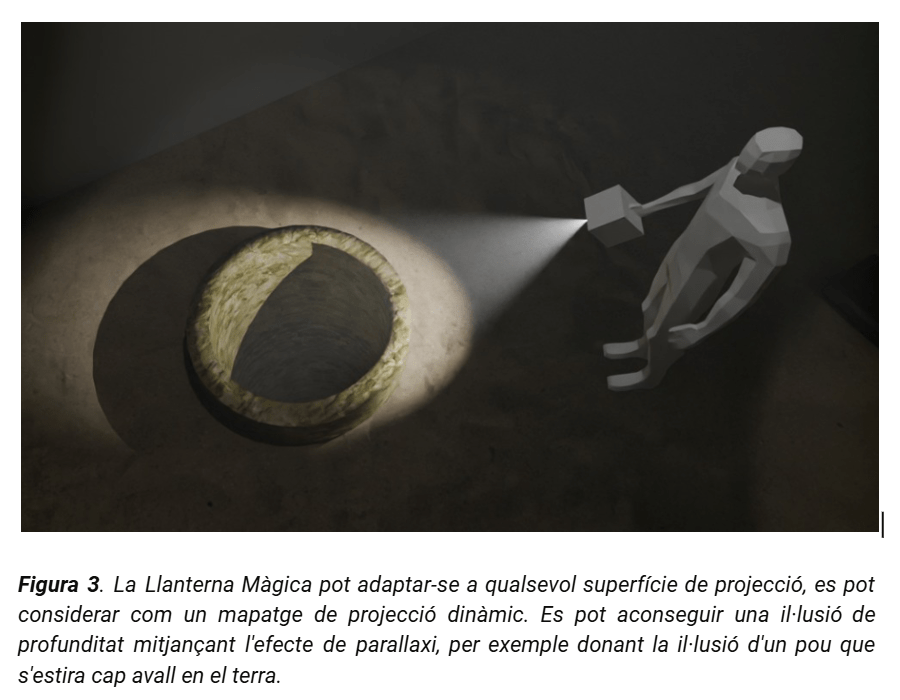RAIN OF ILLUSIONS
The Rain of Illusions project is an immersive, interactive and collective experience that uses very experimental technologies in augmented reality and interaction. It is a group and collaborative experience that has a storytelling based on the current water drought, the absence of rain, and that almost all the reservoirs that lower their level let us see villages, churches and castles that are part of the history of Catalonia.
Climate change and awareness of the importance of the balance of the atmosphere and the earth’s biosphere, the Nesga Hypothesis, are the derrafont of this digital and instal.lative creation. The project is designed to be located in an exhibition space or to use historical constructions: churches, castles, farmhouses, etc. The participating group (from 5 to 8 people) uses a Magic Lantern to find the objects and natural elements that serve to invoke water. As this common test is solved, projections and sounds announce rain and life-giving water. The connection between ecological awareness and the historical heritage of rural areas and natural parks makes us reflect on the need for collective action. This installation can be adapted to specific historical sites and use symbologies that connect with the traditions of ancient and primitive cultures.
The project will be prototyped at Ars Electronica Festival 2024 and then in September or October will be exhibited at ESPRONCEDA, Instituto de arte and culture. The project is supported by the Universitat Pompeu Fabra, UPF.
TECHNOLOGIES IMPLEMENTED
In the RAIN OF ILLUSIONS project we will use a number of new projection techniques with the full-body interaction lab at UPF, such as the Magic Lantern, a handheld AR device that allows users to ‘light a torch’ to explore a virtual world in real time. The main images were rendered to Unity by our lead developer: Fran Macia.


Our set will incorporate two projectors mapped to real scenographic elements, as well as possible Arduino and Raspberry-Pi based interactive elements that can enable practical interactions (such as interaction triggered by picking up an object). The physical interactions will be implemented by our Computational Artist, Rafa Roeder (Goldsmiths). We will use NDI, and possibly Photon (Unity) to create a networked experience where our visuals, audio and physical set can work together to create a reactive world. Surrounding sound speakers, carefully hidden from the environment, will provide a shared soundscape that unites all the audiovisual elements and gives a sense of space.
INNOVATION IN THE EXPERIENCE: IMMERSIVE+INTERACTIVE+COLLECTIVE= SOCIAL IMPACT+INCLUSION
The proposed immersive/interactive experience is done collectively and has a usability/gamification to be understood/experienced by all types of users. It encourages collective work for the achievement of a common lamb and the awareness of the balance of the terrestrial ecosystem and the need for water as a generator of life.
INNOVATION IN EXHIBITIVE PLACES and GENERATION OF NEW AUDIENCES
The storytelling on which the LLUVIA De ILUSIONES experience is based follows a new trend of using historical and linked spaces in the territories as new immersive digital experiences. This type of project revitalises natural spaces, rural areas and initiates collaborations for digital productions beyond urban centres and large cultural institutions.

INNOVATION and TECHNICAL EXPERIMENTATION
The key innovations here are the use of multiple real-time projections, possibly including a portable augmented relay Magic Lantern, as well as small interactive displays integrated into the set, to create a coherent story world that evolves over approx. 10/12 minutes duration.
This will require networking our projectors, physical elements of the set and the speaker array, probably with NDI.
Physical elements in the exhibition space can be modified with Arduino and Raspberry, or second screens, to provide additional immersion.
There are possibilities to extend our use of augmented reality to headsets, by streaming a la Oculus Quest 3.
Overall, this is a mixed reality approach, exploring new projection techniques and computational art to create a coherent immersive world.



The system diagram applied to the Magic Lantern is shown below.

Below are the images of the Leaf-Body Interaction Lab at the Universitat Pompeu Fabra.





For further information, please visit the project website:
